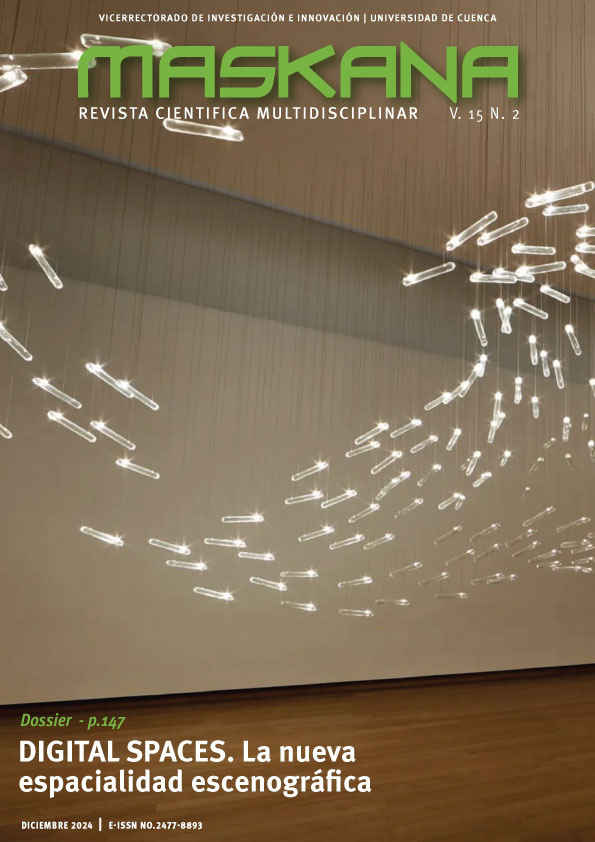Impact of Substance Use and Gender-Based Violence on Mental Health and Decision-Making under risk and under ambiguity: Insights from the Iowa Gambling Task in Incarcerated Populations
DOI:
https://doi.org/10.18537/mskn.15.02.07Keywords:
Decision-making, substance abuse, domestic violence, rehabilitation, psychopathologyAbstract
Research on inmates' decision-making, health, temperament, and psychopathology highlights the importance of mental health and rehabilitation in prisons. The study focuses on the high prevalence of mental disorders, examining personality and decision-making, particularly in those with substance abuse and domestic violence histories. It emphasizes the need for targeted interventions in correctional settings. This study assessed decision-making under ambiguity and risk in 51 male inmates from the Provincial Prison of Granada, including those with histories of drug abuse, domestic violence, or neither. Decision-making was evaluated using the Iowa Gambling Task, while mental and physical health were measured with the SF-36, personality with the TCI-R, and psychopathology with the MCMI-IV. No significant differences in decision-making were found across prisoner groups. However, those with substance abuse and domestic violence histories exhibited consistently poor decision-making. The domestic violence group scored significantly lower in Block 5 compared to those without such histories. This group also showed greater physical limitations, emotional dependency, and compulsive behaviors. The substance abuse group exhibited higher novelty seeking, antisocial behavior, aggression, borderline personality disorder symptoms, alcohol abuse, and depression. The study underscores the impact of substance abuse and domestic violence on decision-making, psychological traits, and physical health among incarcerated men. It highlights the need for tailored interventions to address specific cognitive and behavioral issues, which could enhance rehabilitation outcomes and reduce recidivism.
Downloads
Metrics
References
Alemayehu, F., Ambaw, F., & Gutema, H. (2019). Depression and associated factors among prisoners in Bahir Dar Prison, Ethiopia. BMC psychiatry, 19(1), 88. https://doi.org/10.1186/s12888-019-2071-1
Allen, S., Flaherty, C., Gretchen, E. (2010). Throwaway Moms: Maternal incarceration of the criminalization of female poverty. Journal of Women and Social Work, 25(2), 160–172.
Allnutt, S., Wedgwood, L., Wilhelm, K., & Butler, T. (2008). Temperament, substance use and psychopathology in a prisoner population: implications for treatment. The Australian and New Zealand journal of psychiatry, 42(11), 969–975. https://doi.org/10.1080/00048670802415350
Alonso, J., Prieto, L., y Antó, J. M. (1995). La versión española del SF-36 Health Survey (Cuestionario de Salud SF-36): un instrumento para la medida de los resultados clínicos. Medicina Clínica, 104(20), 771-776.
Andrews, D.A., Bonta, J. and Wormith, S.J. (2006), The recent past and near future of risk and need assessment, Crime & Delinquency, 52(1), 7-27.
Applegate, B. K., Pasquire, N., & Ouellette, H. M. (2024). The Prevalence of Physical and Mental Health Multimorbidity Among People Held in U.S. Jails. Journal of correctional health care: the official journal of the National Commission on Correctional Health Care, 30(1), 7–13. https://doi.org/10.1089/jchc.23.05.0040
Balcioglu, Y. H., Kirlioglu Balcioglu, S. S., Oncu, F., & Turkcan, A. (2021). Psychopathy, temperament, and character dimensions of personality as risk determinants of criminal recidivism in schizophrenia patients. Journal of forensic sciences, 66(6), 2340–2353. https://doi.org/10.1111/1556-4029.14834
Beaudette, J. N., & Stewart, L. A. (2016). National Prevalence of Mental Disorders among Incoming Canadian Male Offenders. Canadian journal of psychiatry. Revue canadienne de psychiatrie, 61(10), 624–632. https://doi.org/10.1177/0706743716639929
Bechara, A., Damasio, A. R., Damasio, H., & Anderson, S. W. (1994). Insensitivity to future consequences following damage to human prefrontal cortex. Cognition, 50(1-3), 7–15. https://doi.org/10.1016/0010-0277(94)90018-3
Bechara, A. (2007). Iowa Gambling Task Professional Manual. Psychological Assessment Resources, Inc.
Block, R. A., Hancock, P. A., & Zakay, D. (2010). How cognitive load affects duration judgments: A meta-analytic review. Acta psychologica, 134(3), 330–343. https://doi.org/10.1016/j.actpsy.2010.03.006
Brand, M., Fujiwara, E., Borsutzky, S., Kalbe, E., Kessler, J., & Markowitsch, H. J. (2005). Decision-making deficits of korsakoff patients in a new gambling task with explicit rules: associations with executive functions. Neuropsychology, 19(3), 267–277. https://doi.org/10.1037/0894-4105.19.3.267
Brand, M., Recknor, E. C., Grabenhorst, F., & Bechara, A. (2007). Decisions under ambiguity and decisions under risk: correlations with executive functions and comparisons of two different gambling tasks with implicit and explicit rules. Journal of clinical and experimental neuropsychology, 29(1), 86–99. https://doi.org/10.1080/13803390500507196
Brinded, P. M., Simpson, A. I., Laidlaw, T. M., Fairley, N., & Malcolm, F. (2001). Prevalence of psychiatric disorders in New Zealand prisons: a national study. The Australian and New Zealand journal of psychiatry, 35(2), 166–173. https://doi.org/10.1046/j.1440-1614.2001.00885.x
Busemeyer, J. R., & Stout, J. C. (2002). A contribution of cognitive decision models to clinical assessment: Decomposing performance on the Bechara gambling task. Psychological Assessment, 14(3), 253–262. https://doi.org/10.1037/1040-3590.14.3.253
Butler, A., Nicholls, T., Samji, H., Fabian, S., & Lavergne, M. R. (2022). Prevalence of Mental Health Needs, Substance Use, and Co-occurring Disorders Among People Admitted to Prison. Psychiatric services (Washington, D.C.), 73(7), 737–744. https://doi.org/10.1176/appi.ps.202000927
Capezza, N. M., D'Intino, L. A., Flynn, M. A., & Arriaga, X. B. (2021). Perceptions of Psychological Abuse: The Role of Perpetrator Gender, Victim's Response, and Sexism. Journal of interpersonal violence, 36(3-4), 1414–1436. https://doi.org/10.1177/0886260517741215
Churchwell, J. C., Carey, P. D., Ferrett, H. L., Stein, D. J., & Yurgelun-Todd, D. A. (2012). Abnormal striatal circuitry and intensified novelty seeking among adolescents who abuse methamphetamine and cannabis. Developmental neuroscience, 34(4), 310–317. https://doi.org/10.1159/000337724
Collison, K. L., & Lynam, D. R. (2021). Personality disorders as predictors of intimate partner violence: A meta-analysis. Clinical psychology review, 88, 102047. https://doi.org/10.1016/j.cpr.2021.102047
Cooper, J. A., Onyeka, I., O'Reilly, D., Kirk, R., & Donnelly, M. (2022). Record linkage studies of drug-related deaths among former adult prisoners who have been released to the community: a scoping review protocol. BMJ open, 12(3), e056598. https://doi.org/10.1136/bmjopen-2021-056598
Craig A. D. (2003). Interoception: the sense of the physiological condition of the body. Current opinion in neurobiology, 13(4), 500–505. https://doi.org/10.1016/s0959-4388(03)00090-4
Crone, E. A., & van der Molen, M. W. (2004). Developmental changes in real-life decision making: performance on a gambling task previously shown to depend on the ventromedial prefrontal cortex. Developmental neuropsychology, 25(3), 251–279. https://doi.org/10.1207/s15326942dn2503_2
De Brito, S. A., Viding, E., Kumari, V., Blackwood, N., & Hodgins, S. (2013). Cool and hot executive function impairments in violent offenders with antisocial personality disorder with and without psychopathy. PloS One, 8(6), e65566. https://doi.org/10.1371/journal.pone.0065566
Derlic D. (2020). A Systematic Review of Literature: Alternative Offender Rehabilitation-Prison Yoga, Mindfulness, and Meditation. Journal of correctional health care: the official journal of the National Commission on Correctional Health Care, 26(4), 361–375. https://doi.org/10.1177/1078345820953837
Diamond, P. M., Wang, E. W., Holzer, C. E., 3rd, Thomas, C., & des Anges Cruser (2001). The prevalence of mental illness in prison. Administration and policy in mental health, 29(1), 21–40. https://doi.org/10.1023/a:1013164814732
Dixon, M. R., Marley, J., & Jacobs, E. A. (2003). Delay discounting by pathological gamblers. Journal of applied behavior analysis, 36(4), 449–458. https://doi.org/10.1901/jaba.2003.36-449
Dolan, P., Hallsworth, M., Halpern, D., King, D., Metcalfe, R., & Vlaev, I. (2012). Influencing behaviour: The mindspace way. Journal of Economic Psychology, 33(1), 264–277. https://doi.org/10.1016/j.joep.2011.10.009
De Wit H. (2009). Impulsivity as a determinant and consequence of drug use: a review of underlying processes. Addiction biology, 14(1), 22–31. https://doi.org/10.1111/j.1369-1600.2008.00129.x
Dumont, D. M., Brockmann, B., Dickman, S., Alexander, N., & Rich, J. D. (2012). Public health and the epidemic of incarceration. Annual review of public health, 33, 325–339. https://doi.org/10.1146/annurev-publhealth-031811-124614
Ehrensaft, M. K., Cohen, P., & Johnson, J. G. (2006). Development of personality disorder symptoms and the risk for partner violence. Journal of abnormal psychology, 115(3), 474–483. https://doi.org/10.1037/0021-843X.115.3.474
Fakhrzadegan, S., Gholami-Doon, H., Shamloo, B., & Shokouhi-Moqhaddam, S. (2017). The Relationship between Personality Disorders and the Type of Crime Committed and Substance Used among Prisoners. Addiction & health, 9(2), 64–71
Fazel, S., Bains, P., & Doll, H. (2006). Substance abuse and dependence in prisoners: a systematic review. Addiction (Abingdon, England), 101(2), 181–191. https://doi.org/10.1111/j.1360-0443.2006.01316.x
Fazel, S., & Danesh, J. (2002). Serious mental disorder in 23000 prisoners: a systematic review of 62 surveys. Lancet (London, England), 359(9306), 545–550. https://doi.org/10.1016/S0140-6736(02)07740-1
Fazel, S., & Baillargeon, J. (2011). The health of prisoners. Lancet (London, England), 377(9769), 956–965. https://doi.org/10.1016/S0140-6736(10)61053-7
Fazel, S., & Seewald, K. (2012). Severe mental illness in 33,588 prisoners worldwide: systematic review and meta-regression analysis. The British journal of psychiatry: the journal of mental science, 200(5), 364–373. https://doi.org/10.1192/bjp.bp.111.096370
Fazel, S., Yoon, I. A., & Hayes, A. J. (2017). Substance use disorders in prisoners: an updated systematic review and meta-regression analysis in recently incarcerated men and women. Addiction (Abingdon, England), 112(10), 1725–1739. https://doi.org/10.1111/add.13877
FeldmanHall, O., Glimcher, P., Baker, A. L., & Phelps, E. A. (2016). Emotion and decision-making under uncertainty: Physiological arousal predicts increased gambling during ambiguity but not risk. Journal of experimental psychology. General, 145(10), 1255–1262. https://doi.org/10.1037/xge0000205
Flórez, G., Vila, X. A., Lado, M. J., Cuesta, P., Ferrer, V., García, L. S., Crespo, M. R., & Pérez, M. (2017). Diagnosing Psychopathy through Emotional Regulation Tasks: Heart Rate Variability versus Implicit Association Test. Psychopathology, 50(5), 334–341. https://doi.org/10.1159/000479884)
Gilmour H. (2014). Positive mental health and mental illness. Health reports, 25(9), 3–9.
Girma, B., Taye, A., Wondimu, W., & Sinaga, M. (2021). Factors associated with depression among prisoners in Mizan prison institute, southwest Ethiopia. International journal of prisoner health, 10.1108/IJPH-11-2020-0093. Advance online publication. https://doi.org/10.1108/IJPH-11-2020-0093
Gori, A., Craparo, G., Sareri, G. I., Caretti, V., Giannini, M., & Meringolo, P. (2014). Antisocial and psychopathic personalities in a sample of addicted subjects: differences in psychological resources, symptoms, alexithymia, and impulsivity. Comprehensive psychiatry, 55(7), 1580–1586. https://doi.org/10.1016/j.comppsych.2014.05.023
Gutiérrez-Zotes, J. A., Bayón, C., Montserrat, C., Valero, J., Labad, A., Cloninger, C. R., & Fernández-Aranda, F. (2004). Inventario del Temperamento y el Carácter-Revisado (TCI-R). Baremación y datos normativos en una muestra de población general. Temperament and Character Inventory Revised (TCI-R). Standardization and normative data in a general population sample]. Actas españolas de psiquiatría, 32(1), 8–15
Hamzeloo, M., Mashhadi, A., & Salehi Fadardi, J. (2016). The Prevalence of ADHD and Comorbid Disorders in Iranian Adult Male Prison Inmates. Journal of attention disorders, 20(7), 590–598. https://doi.org/10.1177/1087054712457991
Hartman, C., Hopfer, C., Corley, R., Hewitt, J., & Stallings, M. (2013). Using Cloninger's temperament scales to predict substance-related behaviors in adolescents: a prospective longitudinal study. The American journal on addictions, 22(3), 246–251. https://doi.org/10.1111/j.1521-0391.2012.12010.x
He, H., Martinsson, P. and Sutter, M. (2012) Group Decision Making under Risk: An Experiment with Student Couples. Economics Letters, 117, 691-693. http://dx.doi.org/10.1016/j.econlet.2011.12.08
Hines, D. A., & Douglas, E. M. (2012). Alcohol and drug abuse in men who sustain intimate partner violence. Aggressive behavior, 38(1), 31–46. https://doi.org/10.1002/ab.20418
Howard, M. O., Kivlahan, D., & Walker, R. D. (1997). Cloninger's tridimensional theory of personality and psychopathology: applications to substance use disorders. Journal of studies on alcohol, 58(1), 48–66. https://doi.org/10.15288/jsa.1997.58.48
Hughes, N., Williams, W. H., Chitsabesan, P., Walesby, R. C., Mounce, L. T., & Clasby, B. (2015). The prevalence of traumatic brain injury among young offenders in custody: a systematic review. The Journal of head trauma rehabilitation, 30(2), 94–105. https://doi.org/10.1097/HTR.0000000000000124
Jarnecke, A. M., Leone, R. M., Kirby, C., & Flanagan, J. C. (2022). Intimate Partner Violence and Couple Conflict Behaviors: The Moderating Effect of Drug Use Problem Severity. Journal of interpersonal violence, 37(1-2), NP1170–NP1196. https://doi.org/10.1177/0886260520922369
Jentsch, J. D., Ashenhurst, J. R., Cervantes, M. C., Groman, S. M., James, A. S., & Pennington, Z. T. (2014). Dissecting impulsivity and its relationships to drug addictions. Annals of the New York Academy of Sciences, 1327, 1–26. https://doi.org/10.1111/nyas.12388
Johnson, S. M., & Greenberg, L. S. (1995). The emotionally focused approach to problems in adult attachment. In N. S. Jacobson & A. S. Gurman (Eds.), Clinical handbook of couple therapy (pp. 121–141). The Guilford Press.
Johnson M. P. (2006). Conflict and control: gender symmetry and asymmetry in domestic violence. Violence against women, 12(11), 1003–1018. https://doi.org/10.1177/1077801206293328
Kaeble, D., Glaze, L., Tsoutis, A., & Minton, T. (2015). Correctional populations in the United States. Bureau of Justice Statistics
Kant Jha, C., & M Donovan, D. (2013). Prison, a missing target to address issues related to drug detoxification and rehabilitation: Nepalese experiences. International journal of prisoner health, 9(4), 208–219. https://doi.org/10.1108/IJPH-06-2013-0027
King, C., Cook, R., Giang, L. M., Bart, G., Hoffman, K., Waddell, E. N., & Korthuis, P. T. (2022). Incarceration and compulsory rehabilitation impede use of medication for opioid use disorder and HIV care engagement in Vietnam. Journal of substance abuse treatment, 134, 108451. https://doi.org/10.1016/j.jsat.2021.108451
Krain, A. L., Wilson, A. M., Arbuckle, R., Castellanos, F. X., & Milham, M. P. (2006). Distinct neural mechanisms of risk and ambiguity: a meta-analysis of decision-making. NeuroImage, 32(1), 477–484. https://doi.org/10.1016/j.neuroimage.2006.02.047
Kristofersson, G. K., & Kaas, M. J. (2013). Stress management techniques in the prison setting. Journal of forensic nursing, 9(2), 111–119. https://doi.org/10.1097/JFN.0b013e31827a5a89
Kuijpers, K. F., Blokland, A. A. J., & Mercer, N. C. (2021). Gendered Perceptions of Intimate Partner Violence Normality: An Experimental Study. Journal of interpersonal violence, 36(3-4), NP1412–1440NP. https://doi.org/10.1177/0886260517746945
Larsen, B. K., Hean, S., & Ødegård, A. (2019). A conceptual model on reintegration after prison in Norway. International journal of prisoner health, 15(3), 282–292. https://doi.org/10.1108/IJPH-06-2018-0032
Lauriola, M., Levin, I. P., & Hart, S. S. (2007). Common and distinct factors in decision making under ambiguity and risk: A psychometric study of individual differences. Organizational Behavior and Human Decision Processes, 104(2), 130–149. https://doi.org/10.1016/j.obhdp.2007.04.001
Lawrence, A. J., Luty, J., Bogdan, N. A., Sahakian, B. J., & Clark, L. (2009). Problem gamblers share deficits in impulsive decision-making with alcohol-dependent individuals. Addiction (Abingdon, England), 104(6), 1006–1015. https://doi.org/10.1111/j.1360-0443.2009.02533.x
Leigh-Hunt, N., & Perry, A. (2015). A systematic review of interventions for anxiety, depression, and PTSD in adult offenders. International journal of offender therapy and comparative criminology, 59(7), 701–725. https://doi.org/10.1177/0306624X13519241
Link, A. J., & Williams, D. J. (2017). Leisure Functioning and Offender Rehabilitation. International journal of offender therapy and comparative criminology, 61(2), 150–170. https://doi.org/10.1177/0306624X15600695
Liu, J., Lambert, E. G., Jiang, S., & Zhang, J. (2022). The connection between work attitudes and Chinese correctional staff burnout. Journal of Criminology, 55(4), 568-585. https://doi.org/10.1177/26338076221127710
Macía, P., Estevez, A., Iruarrizaga, I., Olave, L., Chávez, M. D., & Momeñe, J. (2022). Mediating Role of Intimate Partner Violence Between Emotional Dependence and Addictive Behaviours in Adolescents. Frontiers in psychology, 13, 873247. https://doi.org/10.3389/fpsyg.2022.873247
Magaletta, P. R., Diamond, P. M., Weinman, B. M., Burnell, A., & Leukefeld, C. G. (2010). Preentry Substance Abuse Services: The Heterogeneity of Offender Experiences. Crime & Delinquency, 60(2), 193-215. https://doi.org/10.1177/0011128710362055
Matsumoto, T., Okada, T., Chiba, Y., Ando, K., Yoshikawa, K., & Wada, K. (2006). Nihon Arukoru Yakubutsu Igakkai zasshi = Japanese journal of alcohol studies & drug dependence, 41(1), 59–71
Millon, T., Millon, C., Davis, R. D., & Grossman, S. (2015). MCMI-IV: Millon Clinical Multiaxial Inventory-IV. Pearson Assessments
Miranda, R. B., Goldberg, A., & Bermúdez, X. P. D. (2022). Social reintegration programs for former inmates in Brazil: is there a gender perspective? Programas de reinserção social para egressos do sistema prisional no Brasil: há um olhar para o recorte de gênero? Ciencia & saude coletiva, 27(12), 4599–4616. https://doi.org/10.1590/1413-812320222712.13012022
Miura, H., & Fuchigami, Y. (2016). Impaired executive function in 14-to 16-year-old boys with conduct disorder is related to recidivism: A prospective longitudinal study. Criminal Behaviour and Mental Health, 27(2), 136-145.
Moeller, F. G., & Dougherty, D. M. (2001). Antisocial personality disorder, alcohol, and aggression. Alcohol Research & Health, 25(1), 5–11.
Mohíno, S., Kirchner, T., & Forns, M. (2008). Personality and coping in young inmates: a cluster typology. Psychopathology, 41(3), 157–164. https://doi.org/10.1159/000115953
Monterrosa, A. E., & Hattery, A. J. (2023). Mapping Coercive Violence. Violence against women, 29(9), 1743–1763. https://doi.org/10.1177/10778012221125499
Nestor, P. G., Woodhull, A., Newell, D., O'Donovan, K., Forte, M., Harding, S., & Pomplun, M. (2018). Clinical, Social, and Neuropsychological Dimensions of the Intersection of Addiction and Criminality. The journal of the American Academy of Psychiatry and the Law, 46(2), 179–186. https://doi.org/10.29158/JAAPL.003745-18
Petry, N. M., & Casarella, T. (1999). Excessive discounting of delayed rewards in substance abusers with gambling problems. Drug and alcohol dependence, 56(1), 25–32. https://doi.org/10.1016/s0376-8716(99)00010-1
Retzlaff, P., Stoner, J., & Kleinsasser, D. (2002). The use of the MCMI-III in the screening and triage of offenders. International journal of offender therapy and comparative criminology, 46(3), 319–332. https://doi.org/10.1177/0306624X02463006
Roca M., Torralva T., López P., Cetkovich M., Clark L., Manes F. (2008). Executive functions in pathologic gamblers selected in an ecologic setting. Cognitive and Behavioral Neurology, 21, 1-4
Ross, E. H., & Hoaken, P. N. S. (2011). Executive Cognitive Functioning Abilities of Male First Time and Return Canadian Federal Inmates. Canadian Journal of Criminology and Criminal Justice, 53(4), 377–403. https://doi.org/10.3138/cjccj.53.4.377
Santora, L., Arild Espnes, G., & Lillefjell, M. (2014). Health promotion and prison settings. International journal of prisoner health, 10(1), 27–37. https://doi.org/10.1108/IJPH-08-2013-0036
Schultz, W. P., Khazian, A. M., & Zaleski, A. C. (2008). Using normative social influence to promote conservation among hotel guests. Social Influence, 3(1), 4–23. https://doi.org/10.1080/15534510701755614
Schmitz F, Kunina-Habenicht O, Hildebrandt A, Oberauer K, Wilhelm O. (2020). Psychometrics of the Iowa and Berlin Gambling Tasks: Unresolved Issues with Reliability and Validity for Risk Taking. Assessment, 27(2), 232-245. https://psycnet.apa.org/doi/10.1177/1073191117750470
Stawinska-Witoszynska, B., Czechowska, K., Moryson, W., & Wieckowska, B. (2021). The Prevalence of Generalised Anxiety Disorder Among Prisoners of the Penitentiary Institution in North-Eastern Poland. Frontiers in psychiatry, 12, 671019. https://doi.org/10.3389/fpsyt.2021.671019
Steingroever, H., Pachur, T., Šmíra, M. et al. Bayesian techniques for analyzing group differences in the Iowa Gambling Task: A case study of intuitive and deliberate decision-makers. Psychonomic Bulletin & Review, 25, 951–970 (2018). https://doi.org/10.3758/s13423-017-1331-7
Stijelja, S., & Mishara, B. L. (2022). Preventing suicidal and self-Injurious behavior in correctional facilities: A systematic literature review and meta-analysis. EClinicalMedicine, 51, 101560. https://doi.org/10.1016/j.eclinm.2022.101560
Tadesse, E., Merdassa, E., Abdisa, E., & Tolossa, T. (2022). Magnitude and associated factors of depression among prisoners in Wollega zones, Oromia region, Ethiopia: A cross-sectional study. PloS One, 17(3), e0260920. https://doi.org/10.1371/journal.pone.0260920
Teva, I., Marín-Morales, A., Bueso-Izquierdo, N., Pérez-García, M., & Hidalgo-Ruzzante, N. (2023). Personality characteristics in specialist and generalist intimate partner violence perpetrators. Clinical psychology & psychotherapy, 30(1), 86–96. https://doi.org/10.1002/cpp.2778
Toplak, M. E., Sorge, G. B., Benoit, A., West, R. F., & Stanovich, K. E. (2010). Decision-making and cognitive abilities: A review of associations between Iowa Gambling Task performance, executive functions, and intelligence. Clinical psychology review, 30(5), 562–581. https://doi.org/10.1016/j.cpr.2010.04.002
Unver, Y., Yuce, M., Bayram, N., & Bilgel, N. (2013). Prevalence of depression, anxiety, stress, and anger in Turkish prisoners. Journal of forensic sciences, 58(5), 1210–1218. https://doi.org/10.1111/1556-4029.12142
Van Hoey, J., Moret-Tatay, C., Santolaya Prego de Oliver, J. A., & Beneyto-Arrojo, M. J. (2021). Profile Changes in Male Partner Abuser After an Intervention Program in Gender-Based Violence. International journal of offender therapy and comparative criminology, 65(13-14), 1411–1422. https://doi.org/10.1177/0306624X19884170
Verdejo-García, A., García-Fernández, G., & Dom, G. (2019). Cognition and addiction. Dialogues in clinical neuroscience, 21(3), 281–290. https://doi.org/10.31887/DCNS.2019.21.3/gdom
Vicens, E., Tort, V., Dueñas, R. M., Muro, Á., Pérez-Arnau, F., Arroyo, J. M., Acín, E., De Vicente, A., Guerrero, R., Lluch, J., Planella, R., & Sarda, P. (2011). The prevalence of mental disorders in Spanish prisons. Criminal behaviour and mental health: CBMH, 21(5), 321–332. https://doi.org/10.1002/cbm.815
Vinokur, D., & Levine, S. Z. (2019). Non-suicidal self-harm in prison: A national population-based study. Psychiatry research, 272, 216–221. https://doi.org/10.1016/j.psychres.2018.12.103´
Vilagut, G., Ferrer, M., Rajmil, L., Rebollo, P., Permanyer-Miralda, G., Quintana, J. M., Santed, R., Valderas, J. M., Ribera, A., Domingo-Salvany, A., & Alonso, J. (2005). El Cuestionario de Salud SF-36 español: una década de experiencia y nuevos desarrollos. Gaceta Sanitaria, 19(2), 135–140
Werner, N. S., Jung, K., Duschek, S., & Schandry, R. (2009). Enhanced cardiac perception is associated with benefits in decision-making. Psychophysiology, 46(6), 1123–1129. https://doi.org/10.1111/j.1469-8986.2009.00855.x
Yao, X., Zhang, F., Yang, T., Lin, T., Xiang, L., Xu, F., & He, G. (2019). Psychopathy and Decision-Making: Antisocial Factor Associated with Risky Decision-Making in Offenders. Frontiers in psychology, 10, 166. https://doi.org/10.3389/fpsyg.2019.00166
Yechiam, E., Busemeyer, J. R., Stout, J. C., & Bechara, A. (2005). Using cognitive models to map relations between neuropsychological disorders and human decision-making deficits. Psychological science, 16(12), 973–978. https://doi.org/10.1111/j.1467-9280.2005.01646.x
Yechiam, E., Kanz, J. E., Bechara, A., Stout, J. C., Busemeyer, J. R., Altmaier, E. M., & Paulsen, J. S. (2008). Neurocognitive deficits related to poor decision making in people behind bars. Psychonomic bulletin & review, 15(1), 44–51. https://doi.org/10.3758/pbr.15.1.44
Young, S., Wells, J., & Gudjonsson, G. H. (2011). Predictors of offending among prisoners: the role of attention-deficit hyperactivity disorder and substance use. Journal of psychopharmacology (Oxford, England), 25(11), 1524–1532. https://doi.org/10.1177/0269881110370502
Yousefi, F., & Talib, M. A. (2022). Predictors of personality disorders in prisoners. Journal of medicine and life, 15(4), 454–461. https://doi.org/10.25122/jml-2021-0317
Zgoba, K. M., Reeves, R., Tamburello, A., & Debilio, L. (2020). Criminal Recidivism in Inmates with Mental Illness and Substance Use Disorders. The journal of the American Academy of Psychiatry and the Law, 48(2), 209–215. https://doi.org/10.29158/JAAPL.003913-20
Zhong, S., Yu, R., & Fazel, S. (2020). Drug Use Disorders and Violence: Associations with Individual Drug Categories. Epidemiologic reviews, 42(1), 103–116. https://doi.org/10.1093/epirev/mxaa006
Zois, E., Kortlang, N., Vollstädt-Klein, S., Lemenager, T., Beutel, M., & Mann, K. (2014). Decision-making deficits in patients diagnosed with disordered gambling using the Cambridge Gambling task: the effects of substance use disorder comorbidity. Brain and Behavior. 4(4), 484–494. https://doi.org/10.1002/brb3.231
Downloads
Published
How to Cite
Issue
Section
License
Copyright (c) 2024 Azahara Leonor Miranda Gálvez, José Luis Mata Martín

This work is licensed under a Creative Commons Attribution-NonCommercial-ShareAlike 4.0 International License.
Copyright © Autors. Creative Commons Attribution 4.0 License. for any article submitted from 6 June 2017 onwards. For manuscripts submitted before, the CC BY 3.0 License was used.
![]()
You are free to:
 |
Share — copy and redistribute the material in any medium or format |
 |
Adapt — remix, transform, and build upon the material for any purpose, even commercially. |
Under the following conditions:
 |
Attribution — You must give appropriate credit, provide a link to the licence, and indicate if changes were made. You may do so in any reasonable manner, but not in any way that suggests the licenser endorses you or your use. |
| No additional restrictions — You may not apply legal terms or technological measures that legally restrict others from doing anything the licence permits. |









